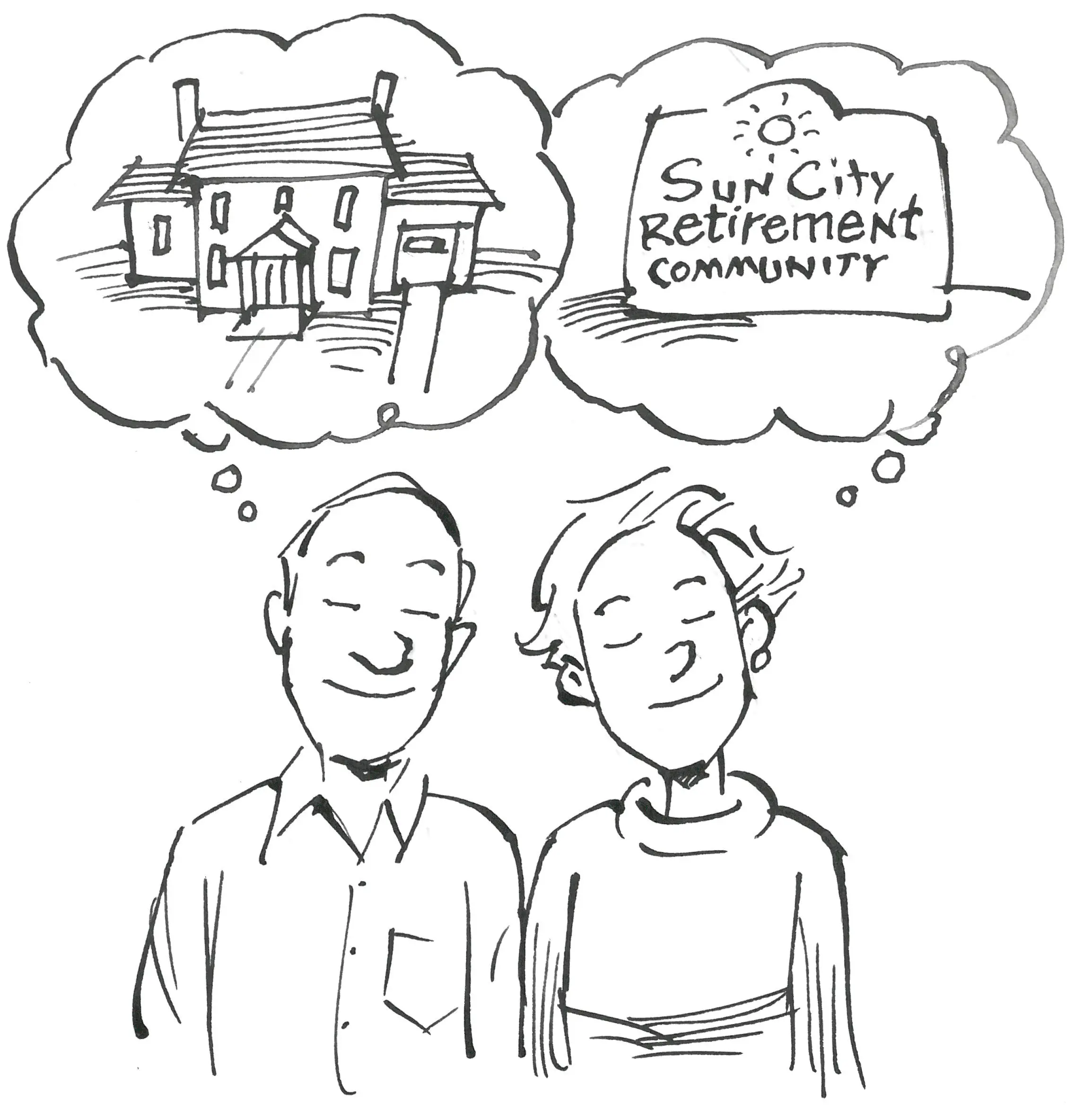1| Making Better Decisions
Making better decisions is the foundation of avoiding fourth quarter fumbles. Everyone comes into the fourth quarter of life with different decision-making skills, regrets about bad decisions they’ve made and fears about making the right decision going forward.
Here are a few ideas from the Fourth Quarter Fumbles book on making better decisions
Show More

1. Make a puzzle out of a problem – our brains are taught at an early stage to engage at a different level on a puzzle. Considering a fourth quarter problem as a puzzle can also help reduce disagreements between life partners.
2. Admit being right isn’t the goal – pride and ego influencing decisions are often the cause of fourth quarter fumbles.
3. Have a trusted decision helper – bouncing possible decisions off a few people you trust who have common sense is a key to better decision-making throughout life, and especially important in the fourth quarter of life. These people can include your life partner, friends and one or more professional advisors.
Stearns Financial Group has helped clients in many areas of the fourth quarter of their life make better decisions in both financial and non-financial areas. We are a long-term, trusted sounding board for many clients with a network of fourth quarter resources to help you make better, more informed decisions.
2| Having a Good Transition Plan
Change is difficult. Most people need to transition to a radically new life in small steps and adjust more gradually to the changes over time. Surprisingly, less than 3% of Americans have any kind of retirement plan at all, and even fewer have a good plan for the transition from the third quarter of their lives to the fourth. What makes it doubly hard is when two life partners are at different ages, stages, or on different transition patterns, which makes it more likely the relationship will destabilize, temporarily or permanently.

Having a transition plan is key to avoiding fumbles. Just figuring out when to retire can mean the difference between success and failure. Most people interpret this sentence as referring to “having enough money to retire.” That is an important consideration to be sure but being ready to retire is much more about being prepared emotionally for a whole new chapter of your life. And prepared for the dangers that lie ahead.
A transition plan is different than a financial plan. The most ideal transition plans can be very simple. It should be individually suited to you and your personality and goals. It should be top of mind at all times so when you encounter inevitable challenges, you have a “true north star” to guide you.
Ask the right questions. If you’re married, do this together with your spouse or life partner, or do it separately and then compare the results. If you’re single, do this with a close friend. Discuss your answers with close friends, family, and your financial planner to get good reality checks on your answers.
What am I going to do with more free time? Usually answered by a mix of How Much?, Why?, Who? and Where?
Does my circle of friends include the right people to hang around as I age? The important Who? question.
If I’m going to have more time than my parents in the fourth quarter, do I need an “encore” career, paid or unpaid? What should I do that will make me happy in that career and will also leave time for other pursuits? Sometimes dictated by the How Much? answers and part of having a satisfying Why? later in life.
Are we happy in our current home or hometown? Should we consider a move or downsize in stage 1 (the go-go years) of the fourth quarter or should we wait until later to see where children and grandchildren will be living? Your How Much? and Where? questions at different points in the fourth quarter.
What will I do every day of the week? Your Why? and your Who? (See the sample questionnaire in Appendix 1).
Where do I want to travel with my spouse or life partner? Part of the Where? equation.
Where do I want to travel alone or with my best friends? How will my life partner feel about that? Important Who? questions.
What do I want to learn to keep myself sharp, fresh, and interesting? This helps your Why? and your Who?
The fourth quarter includes numerous transitions, first to not working and then to other stages as you move through the go-go years to the slow-go years to no-go years. SFG’s Financial Independence Roadmap™ includes helping you consider the opportunities and potential fumble areas in these transitions before or as they occur.
3| A Balanced Finance and Investment Strategy
Many people in the previous generation entered the fourth quarter with pensions. They lived off Social Security and the pension, not counting on withdrawals from investment portfolios as much. For the most part, those days are gone and the financial issues when you must “make your own paycheck” are more complex than ever.

Key financial planning and investment issues include the following:
Investing allocations that take into account not only personal factors—your age, your stage of life, your financial circumstances (including how much you spend relative to your portfolio size)—but also external factors such as economic, geopolitical, and political risks that could derail your laid plans. These external factors could also include shifts in risk versus potential return in bonds, stocks, real estate, and other asset classes; tax risks; and Super Trend forces (for instance, globalization and technology accelerators such as automation, demographics, and urbanization).
How you are personally affected by inflation. The U.S. government’s Consumer Price Index is based on a hypothetical spending pattern that we rarely see in real life. In recent years, things we need (basics of life including food and health care) have been experiencing higher inflation rates than the things we want, such as the latest electronic gadgets or vacation cruises.
If your go-go and slow-go years are extended, do you have enough set aside and invested properly to buy the same loaf of bread and jug of milk (or health care) 20 years from now when they may cost 50% more (or possibly higher) than they cost today?
How do you balance living well in your go-go years versus your slow-go years? Some people after 9/11 decided life is short and uncertain, so they would live it up more in the go-go years. There is something to be said for this approach, living well while your health permits. But moderation is also important, especially so if you have more limited financial resources.
Are your assets and finances set up to provide the margin of safety you need as you reach various milestones in the fourth quarter? Do you have a good, well researched plan for How Much you need?
Our experience and advanced training can assist clients with shifting their financial planning and investment strategy as they age. The asset allocation playbook of the past may not work well in the future – many options need to be considered.
4| Having a Good Reason to Get Out of Bed
This is your all-important Why? When people didn’t live as long in the fourth quarter of their lives, having a reason to get out of bed wasn’t as critical. By the time they had played enough golf and tennis and travelled, they were getting chronic ailments that limited their mobility and lifestyle. If you have 20 good years ahead of you at age 65, with minimal chronic ailments, what would you do to stay engaged in life and feel your life has a higher purpose?

Have you filled out your “bucket list” of things that you want to do before you die or get too old to enjoy them? It turns out this is the source of many fumbles in the fourth quarter! Many people become so obsessed with their bucket to-do list that they spend less time with children and grandchildren (and sometimes even their life partners), creating the very disaster they thought they were avoiding.
As the fourth quarter progresses into the stage 3 no-go years nearer the end of life, most people begin to reflect on what they will leave as a legacy in the world. For many it’s their children and grandchildren, hopefully happy, healthy, and employed. For others it’s helping their favorite community cause and perhaps even setting up a donor-advised fund at a community foundation. For those with a higher net worth, setting up their own private foundations may be part of their legacy planning.
Do you have a compelling reason to stay engaged with the world as you age? The all-important “Why?” that can mean the difference between thriving in the fourth quarter and becoming depressed or worse. Stearns Financial Group has specialists trained to help you think through various “Why?” options and provide insight into what has worked or not worked for others in a similar situation.
5| Wellness versus the Absence of Illness
The good news is that the current generation of Americans entering the fourth quarter is the healthiest generation ever despite the obesity epidemic. One cancer professional recently described to me many forms of cancer as “chronic, treatable ailments,” with good reason to believe that more diseases will be treatable, even curable, in the near future. Even a history of poor family health may become, well, history in the next decade. Scientists are learning how to repair genes that spelled trouble for previous generations.

Alzheimer’s disease, one of the most feared maladies in the fourth quarter right beside cancer, may also become a chronic treatable disease in the near future. An incredible amount of research is being done and some traction towards slowing down the disease has been achieved. Stopping it altogether and reversing Alzheimer’s and dementia is a more daunting challenge also being worked on by researchers around the planet.
There is no question that medical science is progressing more rapidly than ever and that early detection of disease is both important and being accomplished, but only if you’re getting checked regularly. The Internet of Things (IoT for short) promises to bring us regular monitoring of vital functions. The Qualcomm “tricorder” challenge helped create a whole new generation of diagnostic tools that are being refined for next generation disease detection.
The bad news is that technological advances are also creating a more sedentary society, good nutrition habits have been overwhelmed by foods that addict our minds and taste buds, the health-care system has become difficult to navigate, many people are on multiple pharmaceuticals with many side effects, and even one serious health problem can derail even a good exercise and nutrition plan. This can create a cascade effect: The positive elements of life can be destabilized by aging problems, creating even more challenges. Many seniors find themselves less resilient to change and adversity, although this risk can be reduced with the right actions.
Are you pursing wellness or just settling for not being ill? Is your exercise program challenging enough? Do you have a competent health-care advocate to help you navigate the health-care system?
Health is our number one asset. The cost of poor health in money and unhappiness later in life is potentially massive. Stearns Financial has helped clients develop better health screening regimens coupled with health advocacy.
6| Social Networks Rule Even in the Fourth Quarter
Good professional and social networks have long been associated with success in life and careers. It turns out that fourth quarter success still requires good networks to be at the top of your game! This is the Who?- the people that you spend time with matter to your fourth quarter success.

In the digital age, location still matters when it comes to maintaining good networks of friends and resources. Over time, even a great network changes because of chronic illness, death, and divorce. A number of people I interviewed in the mid-stage of the fourth quarter talked about how many friends they have “lost” as a result of them moving away to be closer to their own family. Our friendship garden needs to be tended regularly, especially because many people don’t make as many new, close friends as they progress into and through the fourth quarter.
If you haven’t paid attention to your mental and physical wellness program and have become the quintessential grumpy old man or anxious old woman, it won’t be surprising if your network of friends shrinks and shrivels over time: yet another example where inattention to one area causes fumbles in another.
How would you rate your social support network? SFG has a process of helping clients think through their current “Who?” network and develop a wider and stronger network.
7| Communicate Until the Cows Come Home
Communication with spouses and with family members has many new ways to become strained during the fourth quarter. Simply dealing with tough transition issues and feelings of losing your identity can create significant emotions that take over in conversations with your life partner, friends, and family members.

What factors are at play when people of high IQ fail in the fourth quarter and those of modest IQ succeed? Apparently, an outstanding IQ is not a good predictor of fourth quarter success and a strong EQ (emotional intelligence) is a better predictor. EQ is critical for making intelligent How? decisions. Key EQ factors include self-awareness, self-regulation, motivation, empathy, and social skills. If one or more of these is not at a good or higher level, it’s pretty certain you’ll encounter more fumbles than you would like in the fourth quarter.
Are your communication skills up to the challenges of the fourth quarter? Communication between spouses can be challenging in the fourth quarter of life, particularly as our clients have progressed into the slow-go and no-go years. Is everything that should be communicated with children on fourth quarter plans being considered? SFG can help with messaging.
8| Thoughtful Estate Planning
Most people think of estate planning as having a will or avoiding as much tax as possible when passing assets to the next generation. Over two-thirds of Americans don’t have a will (this number jumps to almost three-quarters for minorities), and many need to think more about what happens as the fourth quarter progresses, not just when the buzzer sounds at the end of life. What if you become incapacitated? Can your spouse handle all the healthcare and financial decisions? Is there any danger of elder abuse, with one of your family members bleeding your estate dry?

Recent changes in tax law have made fewer estates subject to estate tax, although there are many other hidden taxes that need to be considered and reduced if possible. Considering if children can handle a large pot of money being dropped in their lap at your death, or how to give them a better chance of success, are other considerations.
Have you updated your estate plan lately? Considered where it might fail? There are many potential fumbles in planning your estate that are not entirely well thought out. Beyond health care powers of attorney and general powers of attorney, what are the expectations for the family as you progress into the slow-go and no-go years?
9| Getting Your Living Options Right
I’ve devoted an entire chapter of the Fourth Quarter fumbles book to long-term living options because so many fourth quarter fumbles happen in this area. Good planning for long-term care involves much more to think about than just whether you have long-term-care insurance. Paying for lifestyle options is important, but over 90% of the fumbles we see in senior-living choices are made by people who can readily afford good care.

Most of the people I work with want to age in place in their home as long as possible. This is likely a more costly choice, and in some cases, especially where dementia is involved, it can be downright dangerous. But for some, this is the right option in terms of comfortable surroundings and the desire to be “in the mainstream population” as long as possible.
Do you have a general idea of your future living alternatives in the fourth quarter living? Have you considered or explored options? SFG regularly analyzes the different practical considerations and financial structures of staying at home versus various continuing care retirement communities, which have a dizzying array of different financial models along with many non-financial pitfalls.
